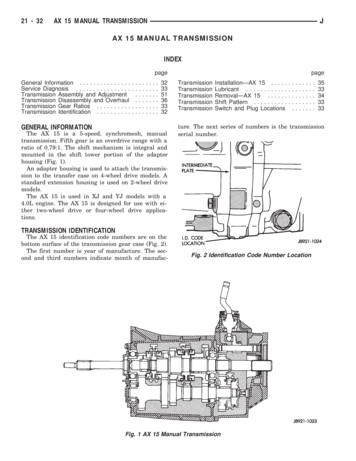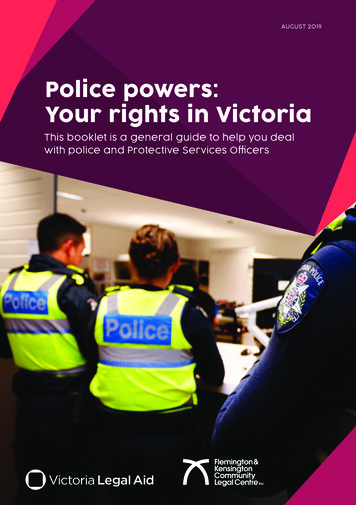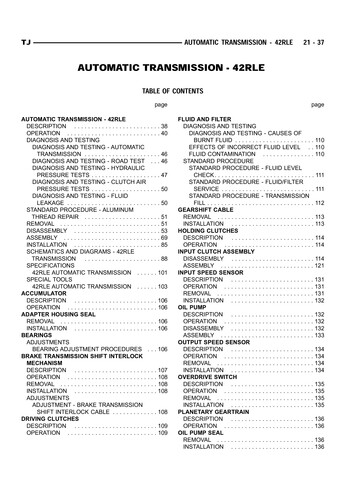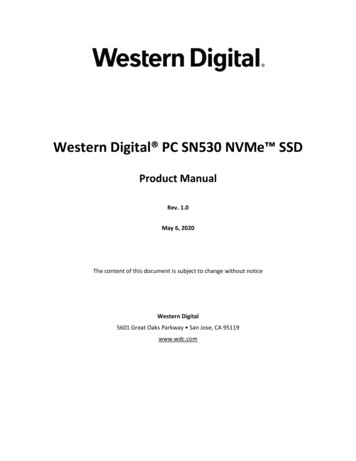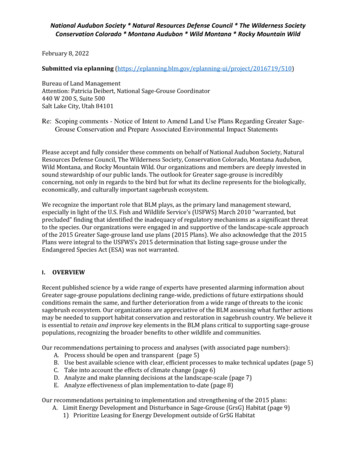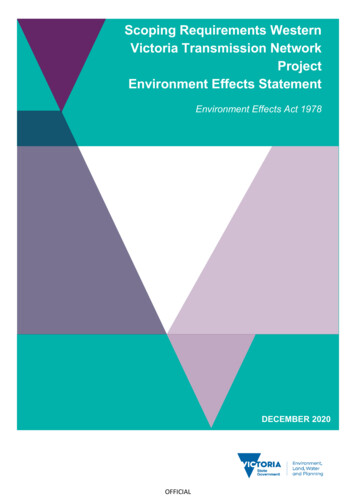
Transcription
Scoping Requirements WesternVictoria Transmission NetworkProjectEnvironment Effects StatementEnvironment Effects Act 1978DECEMBER 2020OFFICIAL
Scoping Requirements for Western Victoria Transmission Network Project EESWe acknowledge and respect Traditional Owners as the original custodians of Victoria’s land and waters,their unique ability to care for country and deep spiritual connection to it. We honour elders past and presentwhose knowledge and wisdom has ensured the continuation of culture and traditional practices.We are committed to genuinely partner, and meaningfully engage, with Victoria’s Traditional Owners andAboriginal communities to support the protection of country, the maintenance of spiritual and culturalpractices and their broader aspirations in the 21st century and beyond. The State of Victoria Department of Environment, Land, Water and Planning 2020This work is licensed under a Creative Commons Attribution 4.0 International licence. You are free to re-use the workunder that licence, on the condition that you credit the State of Victoria as author. The licence does not apply to anyimages, photographs or branding, including the Victorian Coat of Arms, the Victorian Government logo and theDepartment of Environment, Land, Water and Planning logo. To view a copy of the licence, visit creativecommons.org/licenses/by/4.0.DisclaimerThis publication may be of assistance to you but the State of Victoria and its employees do not guarantee that the publication is withoutflaw of any kind or is wholly appropriate for your particular purposes and therefore disclaims all liability for any error, loss or otherconsequence which may arise from you relying on any information in this publication.AccessibilityIf you would like to receive this publication in an alternative format, please telephone theDELWP Customer Service Centre on 136186 or customer.service@delwp.vic.gov.au.This document is also available on the internet at rojects.OFFICIAL
Scoping Requirements for Western Victoria Transmission Network Project EESList of abbreviationsAEMOAustralian Energy Market OperatorCHMPCultural Heritage Management PlanDELWPDepartment of Environment, Land, Water and PlanningEE ActEnvironment Effects Act 1978EESEnvironment effects statementEMFEnvironmental management frameworkEPAEnvironment Protection AuthorityEPBC ActEnvironment Protection and Biodiversity Conservation Act 1999FFG ActFlora and Fauna Guarantee Act 1988GWhGigawatt atters of national environmental significanceMWMegawattsRIT-TRegulatory investment test for transmissionTRGTechnical reference groupiiiOFFICIAL
Scoping Requirements for Western Victoria Transmission Network Project EESContents1. Introduction . 11.1 The project and setting . 11.2 Minister’s requirements for this EES . 32. Assessment process and required approvals . 42.1 What is an EES? . 42.2 The EES process . 42.3 Accreditation of the EES process under the EPBC Act . 53. Matters to be addressed in the EES . 63.1 General approach . 63.2 Content and style . 63.3 Project description . 73.4 Project alternatives . 73.5 Applicable legislation, policies and strategies . 83.6 Draft evaluation objectives . 83.7 Environmental management framework . 84. Assessment of specific environmental effects . 104.1 Biodiversity and habitat . 104.2 Cultural heritage . 134.3 Landscape and visual . 144.4 Land use and socioeconomic . 154.5 Community amenity, safety, roads and transport . 164.6 Catchment values and hydrology . 17Appendix A: Procedures and requirements . 19Appendix B: Controlled action decision . 20ivOFFICIAL
Scoping Requirements for Western Victoria Transmission Network Project EES1. IntroductionIn light of the potential for significant environmental effects, on 4 August 2020 the Minister for Planningdetermined under the Environment Effects Act 1978 (EE Act) that Ausnet Transmission Group Pty. Ltd.,through its commercial arm Mondo, is to prepare an environment effects statement (EES) for the proposedWestern Victoria Transmission Network Project. The purpose of the EES is to provide a detailed descriptionof the project, assess its potential effects on the environment 1 and investigate feasible alternative projectdesigns, alignments and other aspects to avoid and mitigate effects. The EES will inform and seek feedbackfrom the public and stakeholders and enable the Minister to issue an assessment of the project’senvironmental effects at the conclusion of the EES process. The Minister’s assessment of the project’senvironmental effects will inform statutory approval decision-makers.Scoping requirements set out specific matters to be investigated and documented in an EES. While thescoping requirements are intended to cover all relevant matters, the EES will need to address other issuesthat emerge during EES investigations, especially those relevant to statutory decisions that will be informedby the assessment.1.1 The project and settingThe project comprises new high voltage transmission lines connecting an existing terminal station atBulgana, north of Ararat, with a new terminal station to be built adjacent to an existing terminal station atSydenham, on the north-western outskirts of Melbourne (Figure 1). The new transmission lines will operateat 220 kV between Bulgana and another new terminal station, to be built to the north of Ballarat, and at 500kV between that new terminal station and Sydenham. Some works will also be required at existing terminalstations at Ballarat and Elaine (south of Ballarat). The total length of the project is approximately 190km.The alignment for the project is proposed to be located within a broad area of interest of urban, peri-urbanand rural land with tenures that include private land, predominantly used for farming, and public land,managed for conservation or other public purposes (Figure 1). The area of interest is narrower for thewestern component (Bulgana to Waubra) and, in a west to east direction, widens from the Waubra TerminalStation to provide for the new terminal station to the north of Ballarat and to a new terminal station adjacentto the existing Sydenham Terminal Station. Identification and investigation of potential corridors andalignments within the area of interest will be undertaken within the parameters of the EES.The project was analysed by the Australian Energy Market Operator (AEMO) through a regulatoryinvestment test for transmission (RIT-T). AEMO then conducted a competitive tendering process beforeawarding the construction contract to Mondo. The RIT-T and tender award were predicated on an overheaddesign for the transmission lines. This matter is discussed in Section 3.4 below.The proposed overhead transmission line will require lattice towers spaced at intervals of approximately 450550m. Towers will be 40m to 60m high for the 220kV section of the project and 60m to 80m high for the500kV section. The proponent will seek to acquire an easement (a limited interest in the land) in which tobuild and operate the project. The easement will typically be 40m to 60m wide for the 220kV section of theproject and 70m to 100m wide for the 500kV section of the project.The area of interest includes parts of six municipalities and five catchment management authorities. Fiveregistered Aboriginal parties which represent the interests of Traditional Owner groups also have interests inthe project’s area of interest.1Here, ‘environment’ encompasses physical, biological, heritage, cultural, social, health, safety and economic aspects.1OFFICIAL
Scoping Requirements for Western Victoria Transmission Network Project EESFigure 1: Location of the project (source: Ausnet Services – Mondo, Jacobs).2OFFICIAL
Scoping Requirements for Western Victoria Transmission Network Project EES1.2 Minister’s requirements for this EESWhen the Minister decided that an EES was required to assess the project’s potential environmental effects,he published procedures and requirements applicable to the preparation of the EES, in accordance withsection 8B(5) of the EE Act (Appendix A). In the procedures and requirements, the Minister identified broadkey matters and environmental risks that the EES should investigate and document: alternative corridors, alignments, site locations, designs or other options for the planning, construction oroperation of the project; potential effects on biodiversity, including loss, degradation or fragmentation of habitat; effects on Aboriginal and historic cultural heritage values; impacts on visual and landscape values; and other effects on land uses and the community.The EES should address the feasibility of potential environmental mitigation and management measuresassociated with the matters listed above.These scoping requirements provide further detail on the specific matters to be investigated in the EES in thecontext of the Ministerial Guidelines for Assessment of Environmental Effects under the Environment EffectsAct 1978 (Ministerial Guidelines).3OFFICIAL
Scoping Requirements for Western Victoria Transmission Network Project EES2. Assessment process and required approvals2.1 What is an EES?An EES describes a project and its potential environmental effects. It should enable stakeholders anddecision-makers to understand how the project is proposed to be implemented and the likely environmentaleffects of doing so. An EES has two main components.1. The EES main report – an integrated, plain-English document that assesses the potential impacts of theproject on the environment and examines avoidance, mitigation or other measures to reduce theenvironmental effects. The main report draws on technical studies, data and statutory requirements suchas specific limits for surface water and groundwater quality and waste discharge to the environment andshould clearly identify which components of the scope are being addressed throughout.2. The EES technical reports – specialist studies, investigations and analyses that provide the basis for theEES main report. These reports will be exhibited in full, as appendices to the main report.2.2 The EES processThe proponent is responsible for preparing the EES, including conducting technical studies and undertakingstakeholder consultation. The Department of Environment, Land, Water and Planning (DELWP) isresponsible for managing the EES process. The EES process has the following steps 2: preparation of a draft study program and draft schedule by the proponent 3; establishment of an inter-agency technical reference group (TRG) convened by DELWP; preparation and exhibition of draft scoping requirements by DELWP on behalf of the Minister; finalisation of the scoping requirements after considering public comments received during theadvertised exhibition period, for issue by the Minister; commissioning and conducting EES studies, including peer review as appropriate, by the proponent; review of the proponent’s EES studies and draft documentation by DELWP and the TRG 4; completion of the EES by the proponent; review of the complete EES by DELWP to establish its adequacy for public exhibition; exhibition of the proponent’s EES and invitation for public comment by DELWP on behalf of the Minister; appointment of an inquiry (panel) by the Minister to review the EES and public submissions received,and provide a report to the Minister; and finally following receipt of the inquiry report, an assessment of the project’s environmental effects by theMinister for the consideration of statutory decision-makers.Technical reference groupDELWP has convened an agency-based TRG, comprising representatives of relevant state governmentagencies and departments, registered Aboriginal parties and local government authorities. The TRG willadvise DELWP and the proponent on: applicable policies, strategies and statutory provisions; the scoping requirements for the EES; the design and adequacy of technical studies for the EES; the proponent’s public information and stakeholder consultation program for the EES; responses to issues arising from the EES investigations; the technical adequacy of draft EES documentation; and coordination of statutory processes.Consultation planThe proponent is responsible for informing and engaging the public and stakeholders to identify and respondto their issues in conjunction with the EES studies. Stakeholders include landowners, other potentiallyaffected parties, the local community and interested organisations and individuals, as well as governmentbodies. Under its EES consultation plan, the proponent will inform the public and stakeholders about theEES process, the project and associated investigations and will provide opportunities for input andSee also -the-ees-process-in-victoria.The proponent’s draft study program and schedule are part of the iterative process of planning and scoping the EES.4For critical components of the EES studies, peer review will be required.234OFFICIAL
Scoping Requirements for Western Victoria Transmission Network Project EESengagement during the EES investigations. The EES consultation plan is reviewed by DELWP and the TRGbefore it is finalised. The consultation plan will be published on the DELWP website 5. The EES consultationplan will: identify stakeholders; characterise stakeholders in terms of their interests, concerns and consultation needs and potential toprovide local knowledge; describe the consultation methods to be used and outline a schedule of consultation activities during theEES investigations and development of the EES; and outline how inputs from stakeholders will be recorded, considered and/or addressed in the EES.Statutory approvals and the EES processThe project will require a range of approvals under Victorian legislation. DELWP coordinates the EESprocess as closely as practicable with the approvals procedures, consultation and public noticerequirements, in particular the planning approval process.The key approvals known to be required under Victorian legislation are: approved cultural heritage management plans (CHMPs) under the Aboriginal Heritage Act 2006; and planning approvals under the Planning and Environment Act 1987 for use and development of land andassociated matters across six planning schemes (Northern Grampians, Pyrenees, Hepburn, Ballarat,Moorabool and Melton).Other approvals are likely to be required and will be identified throughout the course of the EES.Statutory decisions about approvals required for the project to proceed may not be made before thedecision-makers have considered the Minister’s assessment, which is the final output of the EES process.2.3 Accreditation of the EES process under the EPBC ActThe proponent referred the project to the Commonwealth . A delegate for the Commonwealth Minister forthe Environment determined on 2 September 2020 that the project is a controlled action 6 and requiresassessment and approval under the Environment Protection and Biodiversity Conservation Act 1999 (EPBCAct) (see Appendix B). The provisions for the Commonwealth's controlled action decision are listedthreatened species and ecological communities (sections 18 and 18A of the EPBC Act).The EES process is accredited to assess impacts on matters of national environmental significance (MNES)under the EPBC Act through the Bilateral Assessment Agreement between the Commonwealth and theState of Victoria. The Commonwealth Minister or delegate will decide whether the project is approved,approved with conditions or refused under the EPBC Act, after having considered the Minister for Planning’sassessment under the EE ion-network-projectUnder the EPBC Act, projects are considered as 'actions'. For the purposes of this document the term 'project' also means 'the action'.5OFFICIAL
Scoping Requirements for Western Victoria Transmission Network Project EES3. Matters to be addressed in the EES3.1 General approachPreparation of the EES should be consistent with the principles of a systems approach and a risk-basedapproach 7, so that the environmental effects of and responses to potential impacts are assessed, particularlyfor those that pose a relatively higher risk of adverse effects. The EES should put forward a sound rationalefor the level of assessment and analysis undertaken for any environmental effect or combination ofenvironmental effects 8 arising from construction and operational stages of the project.In the case of potentially significant effects, analyses documented within the EES should be detailed enoughto provide a good understanding of the nature of the effects including: the potential effects on individual environmental assets —magnitude, extent and duration of change inthe values of each asset— having regard to intended avoidance and mitigation measures; the likelihood of adverse effects, including those caused indirectly as a result of proposed activities, andassociated uncertainty of available predictions or estimates; potential cumulative impacts arising in conjunction with other existing or proposed projects; likely residual effects, assuming the proposed measures to avoid and mitigate environmental effects areimplemented; and proposed approach to managing and monitoring environmental performance and contingency planning.3.2 Content and styleTogether with the Minister’s reasons for decision, the published procedures and requirements and theMinisterial Guidelines, the content of the EES and related investigations is to be guided by these scopingrequirements. It is the proponent's responsibility to ensure that adequate studies are undertaken to supportthe assessment of environmental effects, focusing primarily on significant effects (including those that mightemerge during the investigations). The EES should demonstrate how the project will achieve a balance ofeconomic, social and environmental outcomes that contribute to ecologically sustainable development andprovide a net community benefit.The EES should provide a clear, objective and well-integrated analysis of the potential effects of theproposed project, including proposed avoidance, mitigation and management measures, as well as feasiblealternatives. The EES should also address requirements associated with statutory decisions that will beinformed by the Minister’s assessment. Overall, the main report should include: an executive summary of the potential environmental effects of the project outlined in, including potentialeffects on identified MNES; a description of the entire project, including its objectives, rationale and key elements; a description of the relationship of the project to public policies and plans; an outline of the primary approvals required for the project to proceed; descriptions of the existing environment and likely trends, including future climate change scenarios,where these are relevant to the assessment of potential effects; appropriately detailed assessments of potential effects of the project on environmental values, relative tothe ‘no project’ scenario, together with an estimate of the uncertainty associated with predictions; intended measures for avoiding, minimising, managing and monitoring effects; any proposed offset measures where avoidance and mitigation measures will not adequately addresseffects on environmental values, including the identified MNES, and discussion of how any offsetpackage proposed meets the requirements of the Victorian Guidelines for the Removal, Destruction orLopping of Native Vegetation and the EPBC Act Environmental Offsets Policy as it relates to MNES; predictions of residual effects of the project, including residual significant impacts on MNES, assumingimplementation of proposed management measures; responses to issues, including alternative options, raised through public and stakeholder consultation; evaluation of the implications for the project from the implementation of legislation and policy; and conclusions on the significance of impacts on regional, state and federal matters.78Ministerial Guidelines (p. 14).Effects include direct, indirect, combined, facilitated, short and long-term, beneficial, adverse and cumulative effects.6OFFICIAL
Scoping Requirements for Western Victoria Transmission Network Project EESThe proponent may choose to prepare a website with interactive functionality to provide an alternative formof access to EES information, which may complement the conventional EES chapters and technicaldocuments. Such an approach should be discussed with DELWP and should be integrated with thepreparation of the EES package, including review by the TRG.The EES should also outline a program for community consultation, stakeholder engagement andcommunications proposed for implementation during the construction and operation of the project, includingopportunities for local stakeholders to engage with the proponent to seek responses to issues that mightarise during project implementation.The proponent must also prepare a concise, graphical-based, non-technical hard copy summary (A4, nomore than 10 pages) for free distribution to interested parties. The EES summary should include details ofthe EES exhibition, public submission process and availability of the EES documentation.3.3 Project descriptionThe EES is to describe the project in sufficient detail to allow an understanding of all components, processesand development stages, and to enable assessment of their likely potential environmental effects. Theproject description should canvass the following: an overview of the proponent's environmental performance and track record, including experience indelivering similar projects, as well as organisation health, safety and environmental policies, and whetherthe proponent has been subject to any past or present proceedings under a Commonwealth, state orterritory law for the protection of the environment or the conservation and sustainable use of naturalresources; contextual information on the project, including its objectives and rationale, its relationship to statutorypolicies, plans and strategies, including the justification for need for the project, selection of preferredoptions for alignment and design of the project (see Section 3.4 below) and implications of the projectnot proceeding; existing and planned land uses in the vicinity of the proposed project, supported by plans and maps; the proposed operational life of the project, and any decommissioning and rehabilitation arrangements;and other necessary works proposed for the project, such as road upgrades and/or connections, andinfrastructure and services relocation.Description of the project's components should detail: applicable standards and adopted specifications for transmission and terminal station infrastructure; location, footprint, layout and access arrangements during construction and operation; clearing or lopping of native vegetation for construction or operations; design and expected construction staging and scheduling; proposed construction methods and materials, and extent of areas to be disturbed during construction; solid waste, wastewater and hazardous material generation and management during construction andoperation; rehabilitation of site works areas; proposed tenure arrangements to provide for access for maintenance or other operational purposes; lighting, safety, security, and noise requirements during construction and operation; hours of construction work and a description of the expected duration of project components, includingwhich components are temporary and which are permanent; and operational requirements including maintenance activities and decommissioning.3.4 Project alternativesThe EES should document the proponent's design development process leading to the proponent’s preferredform of the project as presented in the EES. The EES should explain the proponent’s criteria for evaluatingthe feasibility of potential alternatives and explain how specific alternatives were shortlisted or rejected forevaluation within the EES. The EES should document the likely environmental effects of feasiblealternatives, particularly where these offer a potential to avoid or minimise adverse environmental effectswhilst meeting the objectives of the project.The referral of the project under the EE Act presented the project in terms of an area of interest rather than aproposed alignment. Alignment selection can be a very important way of avoiding or minimising adverse7OFFICIAL
Scoping Requirements for Western Victoria Transmission Network Project EESimpacts for linear infrastructure projects. Key aspects of the project, for which the EES will need todemonstrate consideration of feasible alternatives, include: the boundaries of the original area of interest; potential corridors and alignments within the area of interest, including criteria for excluding portions ofthe area from further consideration; siting of the new terminal station north of Ballarat, and the extent to which selection of that site influencesthe choice of preferred alignment in either direction; the rationale for the preferred mode of construction (overhead or underground, including potential forpartial underground construction); and other feasible alternatives raised through feedback from the community or other stakeholders.The process for identification and analysis of the project alternatives will need to be documented in the EESincluding: description of alternatives considered in the project design process, including alternative transmissionline alignments and terminal station locations; identification of methods and environmental criteria for comparison of alternatives and for selection ofpreferred alternatives; assessment and comparison of the technical feasibility and environmental implications of alternativeoptions considered; the basis for selecting the preferred project layout and design, particularly where alignments are locatedin proximity to environmentally sensitive areas; and description of how information gathered during the EES process was used to refine the preferredtransmission line alignments and other project alternatives.While the assessment of environmental effects of site selection, alignment and design alternatives mustaddress the matters set out in these scoping requirements, the depth of investigation of alternatives shouldbe proportionate to their potential both to minimise potentially significant adverse effects and to meet projectobjectives. References to “the project area of interest” are to be read as applying iteratively to potentialcorridors or alignments for the project as they emerge within the project area of interest.3.5 Applicable legislation, policies and strategiesIn addition to the EE Act and the EPBC Act, the EES will need to identify all relevant legislation, policies,guidelines and standards, and assess their specific requirements or implications for the project, particularly inrelation to required approvals. The EES should identify and characterise expected or progressing changesto relevant legislation such as the recent passage of a new Environment Protection Act which is expectedcome into effect on 1 July 2021.3.6 Draft evaluation objectivesDraft evaluation objectives are provided in Section 4 for each of the topics to be addressed in the EES. Thedraft evaluation objective
Scoping Requirements for Western Victoria Transmission Network Project EES. OFFICIAL . We acknowledge and respect Traditional Owners as the original custodians of Victoria's land and waters, their unique ability to care for country and deep spiritual connection to it. We honour elders past and present whose knowledge and wisdom has ensured the continuation of culture and traditional .




